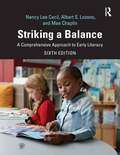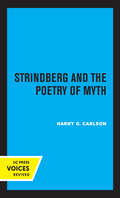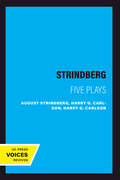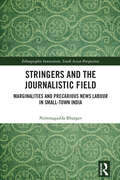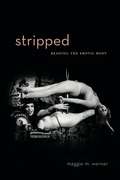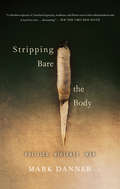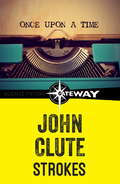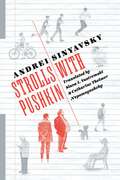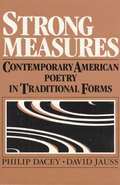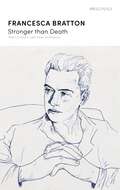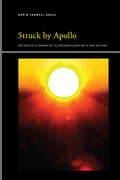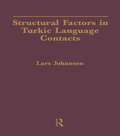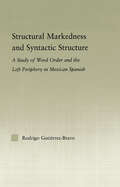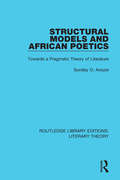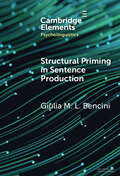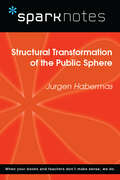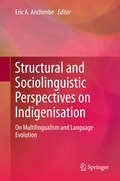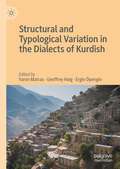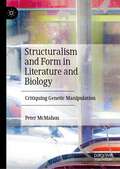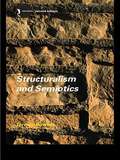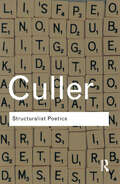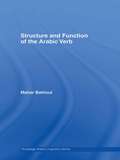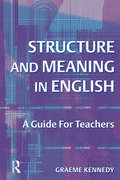- Table View
- List View
Striking a Balance: A Comprehensive Approach to Early Literacy
by Nancy Lee Cecil Mae Chaplin Albert S. LozanoNow in its sixth edition, Striking a Balance clearly illustrates how to create a comprehensive early literacy program that places direct skills instruction within the context of rich and varied reading and writing experiences. <p><p>Text discussions, dynamic activities, and valuable appendices provide a variety of effective instructional resources, selected based on research and teacher testimonials. The sixth edition incorporates recent updates to national and state standards, as well as expanded sections on working with English language learners and students with special needs, while maintaining the book’s essential features: classroom vignettes, discussion questions, field-based activities, a student website, and study guide. <p><p>An essential resource for early literacy instructors, this textbook’s practical approach fundamentally demonstrates how children develop authentic literacy skills through a combination of direct strategy instruction and motivating contexts.
Strindberg and the Poetry of Myth
by Harry G. CarlsonThis title is part of UC Press's Voices Revived program, which commemorates University of California Press’s mission to seek out and cultivate the brightest minds and give them voice, reach, and impact. Drawing on a backlist dating to 1893, Voices Revived makes high-quality, peer-reviewed scholarship accessible once again using print-on-demand technology. This title was originally published in 1982.
Strindberg: Five Plays
by August StrindbergStrindberg's most important and most frequently performed plays—The Father, Miss Julie, A Dream Play, The Dance of Death, and The Ghost Sonata—are gathered together here in translations praised for their fluency and their elegance.
Stringers and the Journalistic Field: Marginalities and Precarious News Labour in Small-Town India (Ethnographic Innovations, South Asian Perspectives)
by Nimmagadda BhargavThis book is one of the first ethnographic works on small-town stringers or informal news workers in Indian journalism. It explores existing practices and cultures in the field of local journalism and the roles and spaces stringers occupy. The book outlines the caste, gender, class and region-based biases in the production of Indian-language journalism with a specific focus on stringers working in Telugu dailies in small towns or ‘mofussil’ areas of Andhra Pradesh and Telangana, states in south India. Further, it captures their daily work and processes of news production, and the precarious lives they often lead while working in small towns or mofussils. The author, by using Bourdieu’s field theory, introduces the journalistic practices of stringers working on the margins and how they negotiate the complex hierarchies that exist within the journalistic field and outside it. This book will be of great interest to scholars and researchers of ethnography, media sociology, journalism and media studies, labour studies and Area studies, especially South Asian studies.
Stripped: Reading the Erotic Body (RSA Series in Transdisciplinary Rhetoric #14)
by Maggie M. WernerStripped examines the ways in which erotic bodies communicate in performance and as cultural figures. Focusing on symbols independent of language, Maggie M. Werner explores the signs and signals of erotic dance, audience responses to these codes, and how this exchange creates embodied rhetoric.Informed by her own ethnographic research conducted in strip clubs and theaters, Werner analyzes the movement, dress, and cosmetic choices of topless dancers and neo-burlesque performers. Drawing on critical methods of analysis, she develops approaches for interpreting embodied erotic rhetoric and the marginal cultural practices that construct women’s public erotic bodies. She follows these bodies out into the streets—into the protest spaces where sex workers and anti-rape activists challenge discourses about morality and victimhood and struggle to remake their own identities. Throughout, Werner showcases the voices of these performers and in the analyses shares her experiences as an audience member, interviewer, and paying customer. The result is a uniquely personal and erudite study that advances conversations about women’s agency and erotic performance, moving beyond the binary that views the erotic body as either oppressed or empowered.Theoretically sophisticated and delightfully intimate, Stripped is an important contribution to the study of the rhetoric of the body and to rhetorical and performance studies more broadly.
Stripped: Reading the Erotic Body (RSA Series in Transdisciplinary Rhetoric)
by Maggie M. WernerStripped examines the ways in which erotic bodies communicate in performance and as cultural figures. Focusing on symbols independent of language, Maggie M. Werner explores the signs and signals of erotic dance, audience responses to these codes, and how this exchange creates embodied rhetoric.Informed by her own ethnographic research conducted in strip clubs and theaters, Werner analyzes the movement, dress, and cosmetic choices of topless dancers and neo-burlesque performers. Drawing on critical methods of analysis, she develops approaches for interpreting embodied erotic rhetoric and the marginal cultural practices that construct women’s public erotic bodies. She follows these bodies out into the streets—into the protest spaces where sex workers and anti-rape activists challenge discourses about morality and victimhood and struggle to remake their own identities. Throughout, Werner showcases the voices of these performers and in the analyses shares her experiences as an audience member, interviewer, and paying customer. The result is a uniquely personal and erudite study that advances conversations about women’s agency and erotic performance, moving beyond the binary that views the erotic body as either oppressed or empowered.Theoretically sophisticated and delightfully intimate, Stripped is an important contribution to the study of the rhetoric of the body and to rhetorical and performance studies more broadly.
Stripping Bare the Body: Politics Violence War
by Mark DannerFor the past two decades, Mark Danner has reported from Latin America, Haiti, the Balkans, and the Middle East. His perceptive, award-winning dispatches have not only explored the real consequences of American engagement with the world, but also the relationship between political violence and power. In Stripping Bare the Body, Danner brings together his best reporting from the world’s most troubled regions-from the fall of the Duvalier dictatorship in Haiti to the tumultuous rise of Aristide; from the onset of the Balkan Wars to the painful fragmentation of Yugoslavia; and finally to the disastrous invasion of Iraq and the radical, destructive legacy of the Bush administration. At a time when American imperial power is in decline, there has never been a more compelling moment to read these urgent, fiercely intelligent reports.
Strokes
by John CluteFor more than 50 years John Clute has been reviewing science fiction and fantasy. Strokes is a collection of reviews from a wide variety of sources - including Interzone, the New York Review of Science Fiction, and Science Fiction Weekly - about the most significant literatures of the twenty-first century: science fiction, fantasy and horror: the literatures Clute argues should be recognized as the central modes of fantastika in our times. It covers the period between 1966 and 1986.
Strokes
by John CluteFor nearly 40 years John Clute has been reviewing science fiction and fantasy. Strokes is a collection of reviews from a wide variety of sources - including Interzone, the New York Review of Science Fiction, and Science Fiction Weekly - about the most significant literatures of the twenty-first century: science fiction, fantasy and horror: the literatures Clute argues should be recognized as the central modes of fantastika in our times. It covers the period between 1966 and 1986.
Strolls with Pushkin (Russian Library)
by Andrei SinyavskyAndrei Sinyavsky wrote Strolls with Pushkin while confined to Dubrovlag, a Soviet labor camp, smuggling the pages out a few at a time to his wife. His irreverent portrait of Pushkin outraged émigrés and Soviet scholars alike, yet his "disrespect" was meant only to rescue Pushkin from the stifling cult of personality that had risen up around him. Anglophone readers who question the longstanding adoration for Pushkin felt by generations of Russians will enjoy tagging along on Sinyavsky's strolls with the great poet, discussing his life, fiction, and famously untranslatable poems. This new edition of Strolls with Pushkin also includes a later essay Sinyavsky wrote on the artist, "Journey to the River Black."
Strong Measures: Contemporary American Poetry in Traditional Forms
by David Jauss Philip DaceyThis anthology helps instruct poets, and students of poetry, in the techniques of formal verse, so that the beauty and power of traditional forms will not be lost to future generations.
Stronger than Death: Hart Crane's Last Year in Mexico
by Francesca Bratton'Poignant and fiercely intelligent, this is the best work of creative non-fiction I have read in years' FIONA MOZLEYIn April 1931, modernist poet Hart Crane arrived in Mexico City. Between mood swings, dire financial difficulties, and a rotating series of personal estrangements, Hart was struggling to make the parts of a fragmentary world cohere. This move to Mexico was one in a long list of attempts to find security. In just over a year he would be dead.In July 1932, Grace Crane picks up the morning paper. Scanning the headlines, she is halted on page five. Her son's eyes stare back at her, tinted pink by the thin paper: 'POET LOST AT SEA FROM SHIP'.Hart Crane's last year has accrued a morbid mythology, seen as a period of self-destructive creative drought. In Stronger than Death Francesca Bratton tracks Hart's year among the vibrant artistic and political communities of Mexico City. His story is interwoven with that of his mother, exploring Grace's lifelong frustrated creativity and, after his death, debilitating grief. Finally the book explores Hart's legacy as a queer man and as a poet, informed by Francesca's responses to his work during her own periods of struggling with mental illness.Part-memoir, part-biography, Stronger than Death is a profound and lyrical meditation on grief, mental health, enduring love and the power of poetry.
Struck by Apollo: Hölderlin's Journeys to Bordeaux and Back and Beyond (SUNY series, Insinuations: Philosophy, Psychoanalysis, Literature)
by David Farrell KrellIn the winter of 1801–02, Friedrich Hölderlin traveled more than one thousand kilometers from his home near Stuttgart to Bordeaux, partly on foot, partly by post coach. It took him two months. Then, after four months serving as a tutor, he inexplicably decided to return home. Not long after he set out, his coach was held up by highwaymen, and, with no money, he had to walk the rest of the way. By the time he arrived, he was so disheveled and disoriented his friends did not recognize him. Though Hölderlin was just thirty-two years old, the trip marked the beginning of the end of his active life as one of Germany's greatest poets and thinkers.With more than sixty black-and-white photographs by the author and eighteen historical route maps, Struck by Apollo follows Hölderlin to Bordeaux and back and beyond. David Farrell Krell retraces the journeys in striking detail, reflecting on their significance for Hölderlin's life and work in ways that will interest a wide swath of fellow thinkers and travelers.
Structural Factors in Turkic Language Contacts
by Lars JohansonTurkic languages present particularly rich sources of data for the study of language contact, given the number and diversity of languages with which they have been in contact. Many common, false generalisations are laid bare and the methodology used in evaluating particular instances of language contact can also be used with profit by students of languages other than the Turkic.
Structural Markedness and Syntactic Structure: A Study of Word Order and the Left Periphery in Mexican Spanish
by Rodrigo Gutiérrez-BravoFirst Published in 2006. Routledge is an imprint of Taylor & Francis, an informa company.
Structural Models and African Poetics: Towards a Pragmatic Theory of Literature (Routledge Library Editions: Literary Theory #4)
by Sunday O. AnozieIn this pioneering work, first published in 1981, Sunday O. Anozie examines the relevance of structuralism and semiology to literary criticism in general and to African poetics in particular. Behind the growing body of African literature lies an immense reservoir of oral tradition for which the proper tools of analysis and interpretation have yet to be found. This book represents the first comprehensive full-scale exposition, analysis and critique of structuralism by a non-Western and non-European scholar. From an African viewpoint, it examines the roles to be played by structuralism and post-structuralism in the development of the general principles governing poetics and literary creativity in Africa. This title will be of interest to students of literature and literary theory.
Structural Priming in Sentence Production (Elements in Psycholinguistics)
by Giulia M. BenciniThis Element provides an overview of structural priming research across the three main populations on which experimental priming studies have concentrated: adult monolingual speakers, first language learners, second language learners, and bilinguals. Priming studies with monolingual adults were originally designed to inform psycholinguistic models of grammatical encoding in language production. Thanks to the the implicit nature of the task, priming has turned out to be suitable for experimentally addressing questions about linguistic representation and use at the sentence level in speakers of any age. The view that priming is a form of implicit learning has sparked an interest in exploring continuity and life-long learning in language, opening up rich research areas in second language acquisition and bilingualism. Priming rightly deserves to be a part of every language scientist's tool kit.
Structural Transformation of the Public Sphere (SparkNotes Philosophy Guide)
by SparkNotesStructural Transformation of the Public Sphere (SparkNotes Philosophy Guide) Making the reading experience fun! SparkNotes Philosophy Guides are one-stop guides to the great works of philosophy–masterpieces that stand at the foundations of Western thought. Inside each Philosophy Guide you&’ll find insightful overviews of great philosophical works of the Western world.
Structural and Sociolinguistic Perspectives on Indigenisation
by Eric A. AnchimbeDescriptions of new varieties of European languages in postcolonial contexts have focused exceedingly on system-based indigenisation and variation. This volume-while further illustrating processes and instantiations of indigenisation at this level-incorporates investigations of sociolinguistic and pragmatic phenomena in daily social interaction-e. g. politeness, respect, compliment response, naming and address forms, and gender-through innovative analytic frameworks that view indigenisation from emic perspectives. Focusing on postcolonial Cameroon and using natural and questionnaire data, the book assesses the salience of linguistic and sociocultural hybridisation triggered by colonialism and, recently, globalisation in interaction in and across languages and cultures. The authors illustrate how the multilingual nature of the society and individuals' multilingual repertoires shape patterns in the indigenisation and evolution of the ex-colonial languages, English and French, and Pidgin English.
Structural and Typological Variation in the Dialects of Kurdish
by Yaron Matras Geoffrey Haig Ergin ÖpenginThis book offers the first comparative discussion of variation in selected areas of structure in the dialects of Kurdish. The contributions draw on data collected as part of the project on Structural and Typological Variation in Kurdish and stored in the Manchester Database of Kurdish Dialects online resource, as well as on additional data sources. The chapters address issues in lexicon, phonology, and morpho-syntax including nominal case, tense and aspect categories, pronominal clitics, adpositions, word order (with special reference to post-predicate constituents) and connectivity and complex clauses. The materials that inform the analysis consist of a systematic questionnaire-based elicitation covering key features of variation in lexicon and morpho-syntax, and an accompanying corpus of free speech recordings, collected in over 120 locations across the Kurdish-speaking regions in Turkey, Syria, Iraq and Iran and covering mainly the dialects of Northern and Central Kurdish (Kurmani-Bahdini and Sorani), with some consideration of Southern Kurdish. The book will be of interest to students and scholars in fields such as linguistics, linguistic typology, Iranian linguistics and linguistics of the Middle East, and dialectology.
Structuralism and Form in Literature and Biology: Critiquing Genetic Manipulation
by Peter McMahonThe book considers biology in parallel with philosophical structuralism in order to argue that notions of form in the organism are analogous to similar ideas in structuralist philosophy and literary theory. This analogy is then used to shed light on debates among biological scientists from the turn of the 19th century to the present day, including Cuvier, Geoffroy Saint-Hilaire, Dawkins, Crick, Goodwin, Rosen and West-Eberhard. The book critiques the endorsement of genetic manipulation and bioengineering as keys to solving agricultural and environmental problems, suggesting that alternative models have been marginalized in the promotion of this discourse. Drawing from the work of philosophers including Cassirer, Saussure, Jakobson and Foucault the book ultimately argues that methods based on agroecology, supported by molecular applications (such as marker-assisted selection, MAS), can both advance agricultural development and remain focused on the whole organism.
Structuralism and Semiotics (New Accents)
by Terence HawkesPublished in 1977 as the first volume in the New Accents series, Structuralism and Semiotics made crucial debates in critical theory accessible to those with no prior knowledge of the field. Since then a generation of readers has used the book as an entry not only into structuralism and semiotics, but into the wide range of cultural and critical theories underpinned by these approaches.It remains the clearest introduction to some of the most important topics in modern critical theory. A new afterword and fresh suggestions for further reading complete this new edition.
Structuralist Poetics: Structuralism, Linguistics and the Study of Literature (Routledge Classics)
by Jonathan CullerA work of technical skill as well as outstanding literary merit, Structuralist Poetics was awarded the 1975 James Russell Lowell Prize of the Modern Language Association. It was during the writing of this book that Culler developed his now famous and remarkably complex theory of poetics and narrative, and while never a populariser he nonetheless makes it crystal clear within these pages.
Structure and Function of the Arabic Verb (Routledge Arabic Linguistics Series)
by Maher BahloulStructure and Function of the Arabic Verb is a corpus-based study that unveils the morpho-syntax and the semantics of the Arabic verb. Approaches to verbal grammatical categories - the constituents of verbal systems - often rely on either semantic-pragmatic or syntactic analyses. This research bridges the gap between these two distinct approaches through a detailed analysis of Taxis, Aspect, Tense and Modality in Standard Arabic. This is accomplished by showing, firstly, some basic theoretical concerns shared by both schools of thought, and, secondly, the extent to which semantic structures and invariant meanings mirror syntactic representations. Maher Bahloul’s findings also indicate that the basic constituents of the verbal system in Arabic, namely the Perfect and the Imperfect, are systematically differentiated through their invariant semantic features in a markedness relation. Finally, this study suggests that the syntactic derivation of verbal and nominal clauses are sensitive to whether or not verbal categories are specified for their feature values, providing therefore a principled explanation to a long-standing debate. This reader friendly book will appeal to both specialists and students of Arabic linguistics, language and syntax.
Structure and Meaning in English: A Guide for Teachers
by Graeme KennedyStructure and Meaning in English is designed to help teachers of English develop an understanding of those aspects of English which are especially relevant for learners who speak other languages. Using corpus research, Graeme Kennedy cuts to the heart of what is important in the teaching of English. The book provides pedagogically- relevant information about English at the levels of sounds, words, sentences and texts. It draws attention to those linguistic items and processes which research has shown are typically hard for learners and which lead to errors. Each chapter contains: a description of one or more aspects of English an outline of typical errors or problems for learners specific learning objectives listed at the beginning of each chapter exercises or tasks based on ‘real English’ taken from newspapers and other sources. discussion topics which can be worked through independently either as part of a course, or self study With answers to many of the tasks given at the back of the book, this groundbreaking work provides a comprehensive and accessible textbook on the structure and use of the language for teachers of English.
